The duration of the building's operation is directly related to the start of its construction. Correctly mounted ventilation in the foundation of the house will prevent the destruction of floor and wall materials. The durability of residential, non-residential premises and the health of the people in them depend on this stage of work.
You will learn all about the rules and regulations for the construction of a ventilation system to protect the base of the house from the article we have presented. We will tell you about the reasons why moisture removal from the foundation is required. We will acquaint you with the methods proven in practice, the calculation scheme and the installation stages.
The content of the article:
-
Variants of systems and ventilation schemes
- Reasons for regular ventilation
- Organization of natural ventilation
- Forced system device
- When is it possible without ventilation?
-
Specificity of ventilation by air
- Parameter calculation steps
- Ventilation options
- Hole Mounting Process
- Opening protection methods
- Air ducts for the exhaust device
-
Preparation for the construction of the system
- The choice of material for assembly
- Size calculation rules
- Stages of installation of channels
- Determination of the place for construction
- Weighted question assessment
- Subtleties of competent operation
- Signs of poor ventilation
-
Ways to rectify the situation
- Option 1. Completion and modernization of the design
- Option # 2. Reduced moisture penetration
- Option # 2. Exchange or purchase of a new home
- Conclusions and useful video on the topic
Variants of systems and ventilation schemes
The construction of the ventilation system is regulated by domestic SNiPami (Building Code) and international building standards.
Reasons for regular ventilation
Some consequences of the absence or incorrect ventilation system in the foundation:
- The appearance of condensation, a gradual increase to 100% humidity;
- Rotting wooden beams, floors, rough floor construction materials;
- The accumulation of natural gas radon, released from the soil, the inhalation of which leads to oncology;
- Reproduction of mold, fungi, other microorganisms that cause allergic diseases, bronchial asthma.
To comply with the humidity regime, the accumulating moisture must be evaporated and removed from under the floor of the house to the street. Neglecting building regulations can cause irreparable harm to the health of the residents of the house.
Organization of natural ventilation
The choice of ventilation option is determined by economic feasibility.
There are two main ways of arranging natural ventilation:
First method. Installation of special holes in the foundation, called vents or vents.
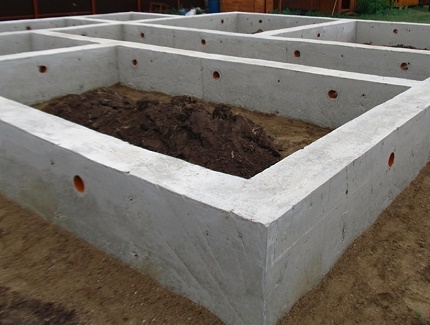
Openings located in opposite walls cause a draft, due to which moisture is removed from the space limited by the foundation
Second method. Supply and exhaust air ducts. They take moisture, harmful gases from the basement and bring it out into the street through exhaust ventilation pipes.
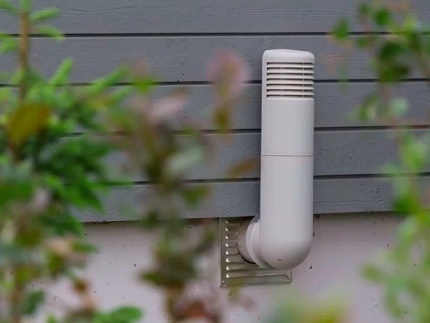
It is possible to arrange one chimney for small basements. Air circulation holes can be made in the floor.
The first method is cheaper in construction, but will require additional costs for heating the house during operation. The second method is effective only with an integrated approach to energy conservation.
It requires high costs for insulating the foundation, creating a waterproofing barrier, construction blind areas, ducts or pipes. Investments will not pay off without carrying out insulation work and high-quality insulation of the whole house from the inside.
Forced system device
Natural ventilation depends on the temperature and density of the air mass outdoors and indoors. It does not work when the outside and basement temperatures are equal. With high humidity and low efficiency, the natural air exchange system is supplemented with electrical appliances and fans.
Forced ventilation is usually used:
- in basements with an area of 40 m2 or with insulated compartments;
- in architectural solutions of a house without ventilation ducts and pipes above the roof;
- in rooms equipped with sources of odors and humidity in the basement - workshop, garage, sauna.
Instrument power supply and exhaust ventilation calculated based on the volume of the basement.
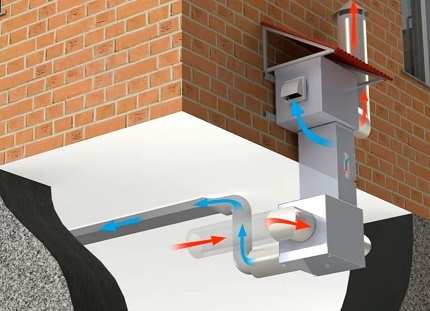
Supply fans intensively pump fresh air from the street, and exhaust fans remove waste streams outside. Usually, the supply and exhaust system is involved either only for the extract or for the supply
In mechanical ventilation systems, either the supply fan or the exhaust fan is activated. If the mechanism works on the inflow, then the air pumped by it spontaneously displaces the spent air mass from the basement. If the hood operates, then the air is drawn into the space rarefied thanks to it, in a natural way.
When is it possible without ventilation?
The need for installation of air ducts or air ducts disappears in any foundation without a subfloor. No basement - no problem.
But not always, but only if at least one of the following two conditions is met:
- A concrete slab was installed on the grillage of a columnar foundation, and the space inside is completely from soil to the floor is filled with a material that filters water well - sand, expanded clay, granular foam glass. Excess moisture in them evaporates quickly and easily.
- Stowed drainage system drainage of water from the foundation. Surplus water is collected by drains - perforated drainage pipes, and discharged into a collection well or sewage pit outside the site.
- A strong waterproofing was installed, wrapping all the elements of the base with a water-resistant layer of glued or welded material, as well as from a complex of materials.
It is possible to dispense with ventilation vents when using a subfloor or basement room as storage. You just need an open passage to the living area of the house and ventilation windows with bars or opening transoms.
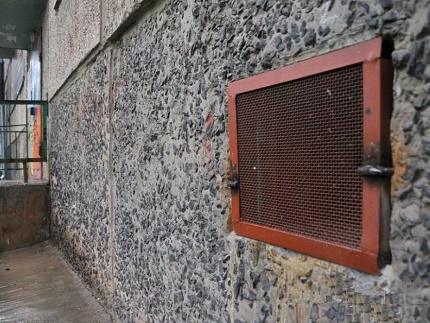
It is permissible not to arrange ventilation vents if ventilation will be carried out by windows and doorways in an equipped operated basement or basement
The homeowner decides for himself whether special vents or air ducts are needed in the foundation of a house with an open basement. Refusal of products in the above cases is allowed by the norms IRS-2006R408.3. In the rest of the foundation structures, a ventilation system is required.
Specificity of ventilation by air
Openings in the foundation for fresh air circulation provide ventilation simply and cheaply. Vents drain condensation well, creating dryness in the basement.
Parameter calculation steps
For efficient ventilation, the number of openings and dimensions are carefully determined. Regulates the location, size, number of vents SNiP 31-01-2003.
During construction, the following requirements must be observed:
- The diameter of the circular section must be at least 25 cm.
- The minimum area of one hole without reinforcement is 0.05-0.85 m2;
- The sum of the cross-sectional area of all vents should be more than 1/400 of the base of the house;
- With an increased content of radon in the soil, the total area of the openings is increased to 1/100 of the basement area.
Most owners of private houses prefer the device of ventilation openings with a minimum allowable cross-sectional diameter, increasing the amount of ventilation if necessary.
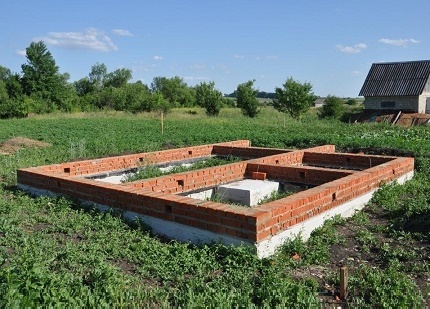
The geometric shape of the vents can be any. The most commonly used are round, square, rectangular sections.
Naturally, if the foundation or basement level is laid with bricks or foam concrete blocks, then the priority is the square configuration of the ventilation vents.
But when pouring a foundation concrete "tape", preference is given to a round section. It is also obtained when drilling structures for a ventilation device after construction.
Ventilation options
The device of exhaust and supply openings has the following features:
- The first blows from each corner are recommended to be done no further than 0.9 m;
- The distance between the holes is set to no more than 3 m;
- The distance from the ground level is from 3/4 to 2/3 of the height of the foundation;
- From the opening to the lower part of the base plane, there must be at least 30 cm;
- Position the vents symmetrically on opposite sides;
- With a low foundation, you will have to dig pits under the air vents.
Openings are also made in the partitions of the basements.
Hole Mounting Process
The sinuses are laid while the concrete is being poured into the "tape" of the foundation. Usually used for mounting plastic pipes. It is necessary to fill them with sand, which prevents deformation and breakage, which is removed after the concrete has dried.
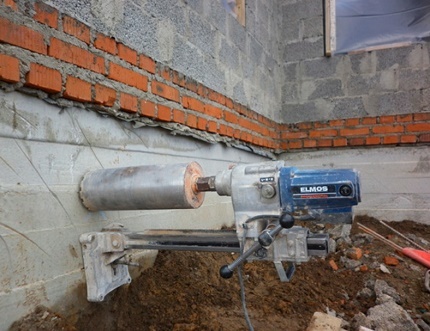
PHOTO 5 If the builders, for some reason, did not do air vents in the process of erecting the foundation, it is necessary to form ventilation holes in the finished structure.
Step-by-step instructions for performing work:
- Draw the future foundation by placing the calculated number of vents on paper with an indication of the dimensions;
- Prepare cut pieces of pipes with sand with a length equal to the width of the foundation "tape", tamp the ends tightly with a rag;
- Lay pieces of pipes, sleeves, in the formwork for pouring concrete, fastening each end of the future air outlet tightly to the walls of the formwork;
- Pour the formwork with the pipes with concrete, after hardening, clean the pipes and install protective gratings.
Do not restrict the holes with wooden blocks when pouring the foundation. Dismantling them will require additional effort, loss of time, and damage to concrete walls.
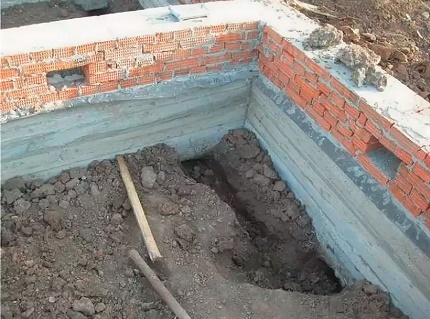
During the construction of a brick foundation or basement with rectangular ventilation holes in cross-section, they will be reinforced overlap. Strengthen the upper part of the masonry with a reinforcing cage. Metal rods are laid over the hole in the horizontal plane
Square holes in masonry are obtained by staggering the elements and using cut bricks.
Opening protection methods
All through vents should be closed with special plugs or valves that allow air to pass through. They protect the base from birds, cats, rats, mice and other small animals.
Various types are used based on personal preference:
- Plastic products have a modern aesthetic design, various shapes, including those in the form of right-angle bends. They are often installed on small openings.
- Sturdy reliable fasteners ensure the durability of the metal doors. Rebar grates, stainless steel meshes welded to the corners are usually used on wide openings.
- For individual orders, beautiful and strong gratings can be made in workshops. They will become not only protective elements, but also decorative ornaments of the facade.
Venetian blinds and grilles made of polymers are used mainly in the arrangement of small-section ventilation openings.
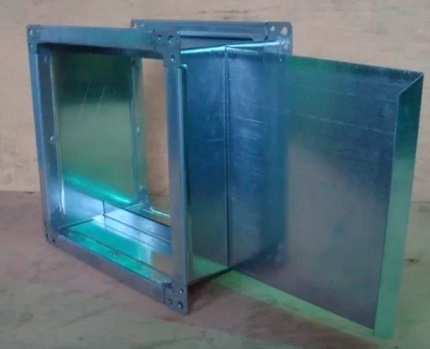
Devices called dampers that regulate the width of the opening will help regulate air exchange. Install them on indoor air ducts
If the ventilation hole in the foundation or plinth is blocked by a stationary grill, it is possible to partially or completely open / close the opening using a gate mounted in the air duct.
Air ducts for the exhaust device
This form of supply and exhaust ventilation is suitable for all types of foundations. The floor on a monolithic, columnar, pile foundation will be as dry and warm as possible with it.
Preparation for the construction of the system
For the installation of exhaust ducts, pipes are usually used or boxes. They can be plastic, metal, brick, wood. Each type of material has its own pros and cons.
The choice of material for assembly
The main differences between the designs:
- Metal ones have a long service life, they slowly get dirty, but they are expensive and difficult to install;
- Easily assembled pipes from PVC, due to the availability of a variety of fasteners, are affordable;
- Wooden boxes are the most inexpensive option, they are environmentally friendly, but less durable.
Which material to choose and how to make reliable ventilation in the foundation, each owner decides, based on their financial capabilities. In large cottages, chimneys are often made of bricks. They are connected to a common duct system and provide good ventilation throughout the house.
Size calculation rules
The exact parameters of the ventilation system guarantee the required air circulation.
- The length of the exhaust pipes is equal to the height of the house plus 1.5 m;
- The duct section must be at least 26 cm2 for each meter of the basement area;
- The total cross-sectional area of the exhaust pipes should be 15% larger than that of the supply pipes.
After carrying out all measurements and calculations, you can start preparing for installation. Check the serviceability of the tool, devices, stock up on material.
Stages of installation of channels
Before starting all work, you should draw up a layout diagram of the elements of the ventilation system.
Installation of air ducts is carried out in the following sequence:
- The supply duct is mounted through a hole in the plinth or in another place, its lower end is located at a distance of 0.5 m from the floor.
- The joints of the pipe in the openings of the foundation are hermetically insulated;
- Exhaust structures are mounted under the ceiling, connected to a common channel with the outer part of the pipe;
Adjustable dampers on the exhaust and supply air ducts will help prevent the basement from freezing in winter.
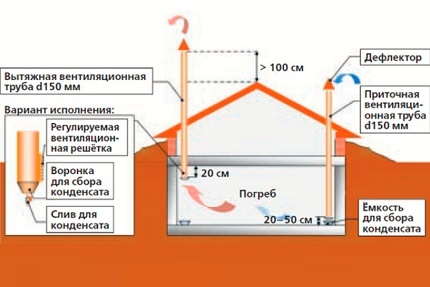
Above the roof, the exhaust riser is mounted vertically, from above it is protected from moisture by a deflector - a metal or plastic "umbrella", the diameter of which is slightly larger than the diameter of the pipe
The height of the ventilation risers above the roof is usually taken equal to the height of the chimneys. In order to ensure stable draft in the hood, the top of the pipe should be 0.5 - 1.0 m higher than the ridge.
Determination of the place for construction
A home built in a well-ventilated area may have a ventilation system with a minimum of vents. It is enough to make only two openings in the foundation. In a structure located in a lowland, the number of vents is increased to the maximum.
The location of the holes should be planned taking into account the wind rose. For example, if the calculations showed the need to equip 6 air vents, then 2 of them should be located on the leeward side, 2 on the opposite windward side and 1 each on the remaining sides of the foundation.
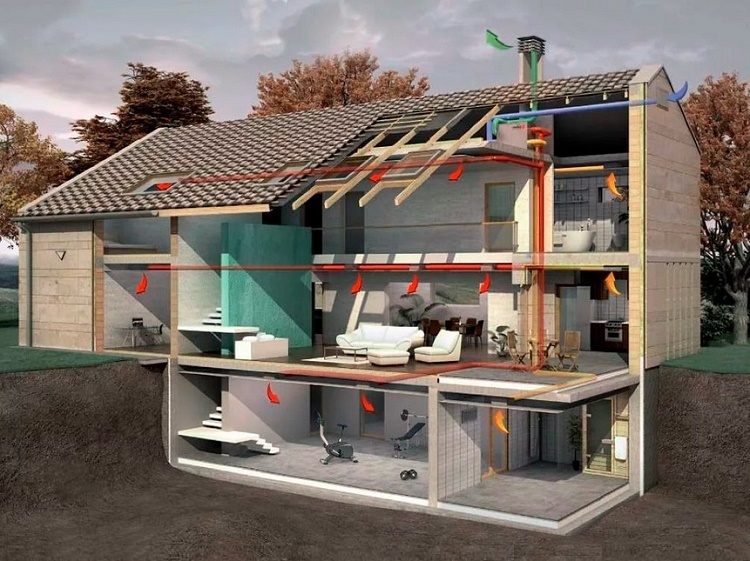
If the basement space is completely submerged in the ground, then it must be equipped with a mechanical ventilation system. In this case, it constructively communicates with the general network, which provides air exchange at home.
Supply and exhaust ventilation, which provides fresh air to the operated premises in the basement, is usually connected to the general ventilation network. So alone recuperator will be able to handle the entire building. In addition, exhaust ventilation ducts can be located in one shaft.
Weighted question assessment
Natural air exchange with the help of vents in the foundation can be done from improvised materials, construction waste. All other options are costly.
Will affect the cost of ventilation:
- Basement area and the height of the entire building when installing air ducts;
- Availability of equipment for forced ventilation. All simple fans and switches can be purchased for 3-5 thousand rubles;
- Additional devices. The cost of complex recuperators, split-systems, hygrometers, sensors with turnkey installation starts from 20 thousand rubles, often exceeds the amount of 100 thousand.
For the well-being of residents and the strength of the house, it is worth choosing an effective foundation ventilation scheme. It can be completely free or very expensive, the main thing is that the air in the basement is renewed and the walls are dry.
The constructed ventilation system requires periodic measures to effectively maintain the microclimate in the basement.
Subtleties of competent operation
It should be remembered that the movement of dry air eliminates condensation. High-quality ventilation is possible with proper operation of the ventilation system.
It is necessary to constantly monitor the state of the weather and carry out simple measures:
- Close air vents during long rains and melting snow in spring.
- Regularly process the inner surface of the foundation with lime or special antifungal impregnations;
- In the fight against excess moisture, you can use boxes with sawdust, sand, salt, periodically replacing the filler with a dry one.
The basement should be ventilated in dry summer heat, and in winter, small gaps in the closed sinuses should be left for traction.
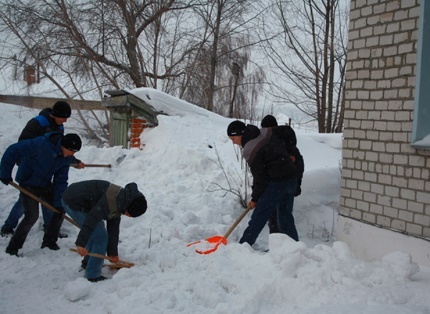
It is imperative to clean the snow near the walls around the entire perimeter of the house in winter, so that during the spring thaw, the water does not flood the foundation.
Even if the base of the house is protected by an efficient wall drainage system, regular snow cleaning is required. During the frosty period, during heavy rainfall, the ventilation vents should not be covered with snowdrifts.
Signs of poor ventilation
Ventilation does not always ensure a high level of preservation of a comfortable microclimate inside the foundation. Sometimes in winter, cold air causes condensation to form when it comes into contact with a warm floor, which causes frost to form on the walls.
The causes of dangerous processes can be:
- Incorrectly calculated number of vents, foundation air ducts;
- Close location of groundwater table, marshland;
- The intake of a large amount of moisture during the rainy season, snow melting.
An imbalance in the ratio between temperature and humidity indicates insufficient ventilation. To establish balance, additional measures are required to drain the basement and adjust the ventilation system.
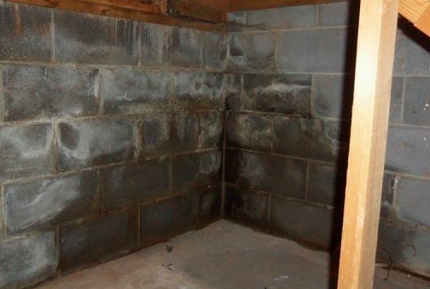
Poor ventilation results in black mold on the foundations and walls. If the structures are not dried, the whole house will be destroyed.
The foundation is called the foundation of the house for a reason. Its destruction due to fungus will inevitably lead to the unusability of the building. Walls damaged by mold can still be saved by partially replacing building materials; these methods are not applicable to the foundation.
Ways to rectify the situation
If there is high humidity under the floor, the fungus began to multiply, this means that the ventilation is not doing its job. The problem has several solutions.
Option 1. Completion and modernization of the design
It is necessary to inspect, make calculations and plan measures to optimize the existing system or install a new one.
To increase the ventilation of the basement, you can:
- Increase the diameter of the existing vents, drill new ones. It is better to use the services of a construction company with diamond drilling equipment.
- Install additional air ducts from the basement to the roof of the house. The increased draft will provide effective moisture reduction.
- Implement a forced ventilation device with an automatic timer. It is convenient to set up a differential thermometer that turns on the fan at the moment when the temperature in the basement begins to exceed the outside temperature.
Small amounts of condensation can be removed using a conventional household fan. Or periodically connect a heat source, for example, a heater.
Option # 2. Reduced moisture penetration
High humidity is usually caused by a high water table. If the ventilation is done as competently as possible, then you need to make or strengthen waterproofing protection. As a material, a polyethylene film with a thickness of 150 microns, roofing felt or its new versions - roll deposited materials is suitable.
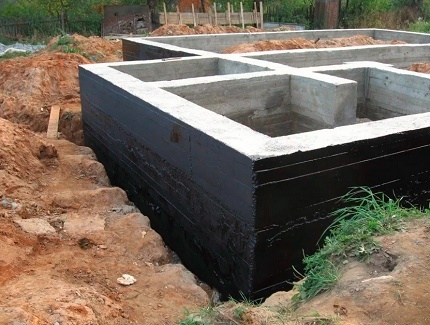
Foundation waterproofing is carried out using bitumen-containing materials. Glued or welded roll options for the type of TechnoNIKOL brand products, bitumen and bitumen-polymer mastics
The process of laying polyethylene on the foundation of a small summer cottage or utility block:
- Lead on the walls of the foundation at a distance of at least 30 cm from the day surface, secure with planks;
- Lay the film in such a way that 15-20 cm one canvas goes over another;
- Carefully glue the joints with double-sided tape on each side of the canvas;
Sprinkle sand with a layer of at least 3 cm or make a small screed to protect the film.
A good effect will be obtained with an insulated plinth with blind area and the presence of a ventilation pipe. If there is no insulation, then the condensation will collect on the film. In this case, you can make a slope in one direction so that the accumulated moisture flows out of the foundation.
Option # 2. Exchange or purchase of a new home
In multi-storey buildings, residents of the first floors sometimes experience unpleasant situations associated with the operation of the basement ventilation system. Management companies should solve such problems. But sometimes they are in no hurry to do this, even in the presence of legal proceedings.

The specific culprit of the accident is determined by the cause of the flood. This may be improper construction, breakdown of communications, seasonal rise in the level of groundwater, floods and others.
Desperate people even try to exchange such apartments or live longer in the country. Sometimes they start building a private residential building on their own and step on the same rake. Therefore, it is very important at the initial stage of laying the foundation to think over and correctly implement the ventilation system.
When building a private house, basement ventilation can be equipped both with your own hands and with the involvement of professional builders.
Conclusions and useful video on the topic
A visual demonstration of the device of ventilation vents after the construction of the house:
The following video will acquaint you with the types of air ducts:
Features of the organization of supply and exhaust ventilation:
Whatever the foundation ventilation system is - simple or complex, budgetary or expensive, it must function correctly. Therefore, home owners must constantly take care of the health of the equipment. It is necessary to try to improve the ventilation system of the foundation, when condensation appears in the basement.
Tell us about how you set up the system in the foundation of your own country house / summer residence. Please leave comments in the block below, ask questions, post photos on the topic of the article. It is possible that site visitors will be happy to use your advice.


